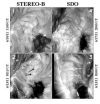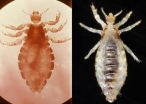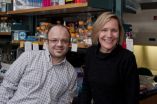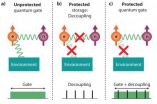(Press-News.org) One day in the fall of 2011, Neil Sheeley, a solar scientist at the Naval Research Laboratory in Washington, D.C., did what he always does – look through the daily images of the sun from NASA's Solar Dynamics Observatory (SDO).
But on this day he saw something he'd never noticed before: a pattern of cells with bright centers and dark boundaries occurring in the sun's atmosphere, the corona. These cells looked somewhat like a cell pattern that occurs on the sun's surface -- similar to the bubbles that rise to the top of boiling water -- but it was a surprise to find this pattern higher up in the corona, which is normally dominated by bright loops and dark coronal holes.
Sheeley discussed the images with his Naval Research Laboratory colleague Harry Warren, and together they set out to learn more about the cells. Their search included observations from a fleet of NASA spacecraft called the Heliophysics System Observatory that provided separate viewpoints from different places around the sun. They describe the properties of these previously unreported solar features, dubbed "coronal cells," in a paper published online in The Astrophysical Journal on March 20, 2012 that will appear in print on April 10.
The coronal cells occur in areas between coronal holes – colder and less dense areas of the corona seen as dark regions in images -- and "filament channels" which mark the boundaries between sections of upward-pointing magnetic fields and downward-pointing ones. Understanding how these cells evolve can provide clues as to the changing magnetic fields at the boundaries of coronal holes and how they affect the steady emission of solar material known as the solar wind streaming from these holes.
"We think the coronal cells look like flames shooting up, like candles on a birthday cake," says Sheeley. "When you see them from the side, they look like flames. When you look at them straight down they look like cells. And we had a great way of checking this out, because we could look at them from the top and from the side at the same time using observations from SDO, STEREO-A, and STEREO-B."
When the cells were discovered in the fall of 2011, the SDO and the two STEREO (short for Solar Terrestrial Relations Observatory) spacecraft each had widely different views of the sun. Thus, as the 27-day solar rotation carried the coronal cells across the face of the sun, they appeared first in STEREO-B data, then in SDO, and finally in STEREO-A, before starting over again in STEREO-B. In addition, when one observatory looked down directly on the cells, another observatory could see them from the side.
The researchers used time-lapse sequences obtained from the three satellites to track these cells around the sun. When an observatory looked down on one of these areas, it showed the cell pattern that Sheeley first noticed. But when the same region was viewed obliquely, it showed plumes leaning off to one side. Taken together, these two-dimensional images reveal the three-dimensional nature of the cells as columns of solar material extending upward through the sun's atmosphere, like giant pillars of gas.
To round out the picture even further, the team turned to other instruments and spacecraft. The original SDO images were from its Atmospheric Imaging Assembly, which takes conventional images of the sun. Another instrument on SDO, the Helioseismic and Magnetic Imager (HMI), provides magnetic maps of the sun. The scientists superimposed conventional images of the cells with HMI magnetic field images to determine the placement of the coronal cells relative to the complex magnetic fields of the sun's surface.
First of all, the magnetic field bundles lay centered inside the cells. This represents a clear distinction between the coronal cells and another well-known phenomenon known as supergranules. Supergranules also appear as a large cell-like pattern on the sun's surface, and their delineated edges are created as the sideways motion of solar material sweeps weaker magnetic fields toward their boundaries. Supergranules, therefore, appear to have enhanced magnetic fields at their edges, while the coronal cells show them at their centers.
Second, the scientists learned more about how the coronal cells were related to other structures on the sun, in their location between a coronal hole and a nearby filament channel. The cells consistently occurred in areas dominated by magnetic fields that point in a single direction, either up or down. In addition, the fields of the nearby coronal hole are what's known as "open," extending far into space without returning to the sun. On the other hand, the field lines in the cells were "closed," looping up over the filament channel and connecting back down to the sun.
The side-by-side nature of these open and closed magnetic fields – open in the coronal holes, and closed in the coronal cells – led to another scientific insight. In some of the movies, a large loop of solar material called a "filament" erupted from the adjacent filament channel. The coronal cells, with their closed field lines, disappeared and were replaced with a dark coronal hole and its associated open field lines.
"Sometimes the cells were gone forever, and sometimes they would reappear exactly as they were," says Sheeley. "So this means we need to figure out what's blowing out the candles on the birthday cake and re-lighting them. It's possible that this coronal cell structure is the same structure that exists inside the coronal holes – but they're visible to us when the magnetic fields are closed, and not visible when the magnetic fields are open."
It has long been known that isolated plumes occur intermittently inside coronal holes when very small active regions erupt there. Presumably, these eruptions are providing glimpses of discrete coronal structures similar to the more permanently visible candles adjacent to the holes. When a portion of a hole closes, the candle-like structure is suddenly lit up by the appearance of cells.
In addition to SDO and STEREO, the team went back to historical data on ESA's and NASA's Solar and Heliospheric Observatory (SOHO), which has provided observations since the previous sunspot minimum in 1996. They did not find coronal cells in 1996 or in the years around the recent sunspot minimum in 2008-2009, but they did find numerous examples of cells in the years around the intervening sunspot maximum in 2000. The recent increase in sunspot activity together with the improved observations from STEREO and SDO may explain why the cells were discovered in 2011.
The team also constructed Doppler images – images that show how quickly and where solar material in the sun's atmosphere moves toward the viewer – of the coronal cells using the Extreme-Ultraviolet Imaging Spectrometer (EIS) on the Japanese Hinode spacecraft. These images show that the centers of the cells move upward faster than their boundaries, further rounding out the physical image of these giant candles with a section rising from the middle.
"One of the wonderful things about SDO is the way the observations can be combined with other instruments," says Dean Pesnell, SDO project scientist at NASA's Goddard Space Flight Center in Greenbelt, Md. " Combining data from SDO, STEREO, SOHO, and Hinode lets us paint a picture of the whole sun in ways that one instrument can't."
The discovery of coronal cells has already increased our knowledge of the magnetic structure of the sun's corona. In the future, studies of the evolution of coronal cells may improve scientists' understanding of the magnetic changes at coronal-hole boundaries and their effects on the solar wind and Earth's space weather.
INFORMATION:
SDO and STEREO spot something new on the sun
2012-04-10
ELSE PRESS RELEASES FROM THIS DATE:
Atlanta Hardwood Flooring Can Be "Baby-Proof" If Done By FlooringAtlantaNow.com
2012-04-10
It shouldn't be surprising to those who have children, that Atlanta Hardwood Flooring is constantly in harm's way from rambunctious babies! The experts at FlooringAtlantaNow are truly masters of the trade, and most recommend using more durable types of wood for high-traffic areas of your home which are prone to scratches or abrasions.
Most Atlanta Flooring specialists agree that winter is the best time to do these types of installations and upgrades to your home. Because metro-Atlanta is known for its mild winters, the season offers a perfect climate which tends to be ...
Black flies may have a purpose after all
2012-04-10
Athens, Ga. – Black flies drink blood and spread disease such as river blindness—creating misery with their presence. A University of Georgia study, however, proves that the pesky insects can be useful.
Don Champagne, an entomology professor with the UGA College of Agricultural and Environmental Sciences, discovered a way to use the black fly's blood-sucking tactics for medical advancement. The results of his research were published in the journal PLoS One.
"In order to feed on blood, these insects have to contend with our natural defense agents against blood loss—like ...
Sexual reproduction brings long-term benefits, study shows
2012-04-10
Courtship rituals can be all-consuming, demanding time and effort – but now scientists have discovered why it might be worth it.
Attracting a mate – which can take significant effort, such as in a peacock's show of feathers or the exhaustive rutting of stags – can produce benefits for a species in the long term, a study suggests.
Scientists have shown that animals and plants which reproduce sexually are at a considerable advantage to those species – such as some insects and reptiles – that reproduce without a partner.
Researchers at the University of Edinburgh studied ...
Genetic regulator of fat metabolism and muscle fitness discovered
2012-04-10
While exercise is accepted universally as the most beneficial prescription physicians can write for patients, little is known about the molecular mechanisms that generate its widespread health benefits. Researchers from Case Western Reserve School of Medicine have shed light on this mystery by discovering that a genetic factor, Kruppel-like Factor 15 (KLF15), governs the body's ability to burn fat during exercise.
Previous research from the laboratory of Mukesh Jain, MD, FAHA, identified the importance of KLF15 in the metabolism of two of the three basic nutrients used ...
Head and body lice appear to be the same species, genetic study finds
2012-04-10
CHAMPAIGN, Ill. — A new study offers compelling genetic evidence that head and body lice are the same species. The finding is of special interest because body lice can transmit deadly bacterial diseases, while head lice do not.
The study appears in the journal Insect Molecular Biology.
Scientists have long debated whether human head and body lice are the same or different species. The head louse (Pediculus humanus capitis) is a persistent nuisance, clinging to and laying its eggs in the hair, digging its mouthparts into the scalp and feeding on blood several times a ...
A bit touchy: Plants' insect defenses activated by touch
2012-04-10
HOUSTON -- (April 9, 2012) -- A new study by Rice University scientists reveals that plants can use the sense of touch to fight off fungal infections and insects. The study, which will be published in the April 24 issue of Current Biology, finds that plant defenses are enhanced when plants are touched.
"From previous studies, we knew that plants change their growth in response to touch but we didn't know how these growth changes were activated," said Wassim Chehab, a faculty fellow in Rice's Department of Biochemistry and Cell Biology and lead author of the new study. ...
Opening the gate to robust quantum computing
2012-04-10
AMES, Iowa -- Scientists have overcome a major hurdle facing quantum computing: how to protect quantum information from degradation by the environment while simultaneously performing computation in a solid-state quantum system. The research was reported in the April 5 issue of Nature.
A group led by U.S. Department of Energy's Ames Laboratory physicist Viatsheslav Dobrovitski and including scientists at Delft University of Technology; the University of California, Santa Barbara; and University of Southern California, made this big step forward on the path to using the ...
O'Reilly Collins Wins $4.6 Million Verdict in Insurance Bad Faith Case
2012-04-10
On March 28, 2012, O'Reilly Collins obtained a verdict in favor of its client, Stephens & Stephens XII, LLC, and against Fireman's Fund Insurance Company for $4,673,125.10 for failure to pay an insurance claim.
Stephens' warehouse was stripped of copper wiring, causing over $2 million electrical and mechanical damages. Stephens was notified of the theft on July 1, 2007 by the Richmond police who apprehended two thieves. Stephens promptly notified its insurance company, Fireman's Fund, of the loss and asked to pay for the repairs. Fireman's Fund initially promised ...
Life expectancy may affect when you get married, divorced, have kids: Queen's University study
2012-04-10
Major life decisions such as marriage, divorce, abortion, having a child and attending university may be subconsciously influenced by how long people believe they will live, according to a Queen's University study.
"Life expectancy might be driving all of these major decisions," says Daniel Krupp, a post doctoral fellow in the Queen's math department who has a background in psychology and biology.
The longer someone expects to live, the more time they will invest in education. If life expectancy is short, someone may decide to get married and have children sooner, or ...
Caution needed when curbing overuse of healthcare resources, study suggests
2012-04-10
NEW YORK, April 9, 2012 – In the current hyper-charged United States healthcare debate, the focus on lowering cost without compromising quality of care remains a priority. But according to a new study by researchers at NYU Langone Medical Center and colleagues, one common approach may have serious unintended consequences.
Funded by the Robert Wood Johnson Foundation's (RWJF) Clinical Scholars program and the United States Department of Veterans Affairs (VA), the study, which appears today in the April issue of Health Affairs, examines the potential impact of policies ...



